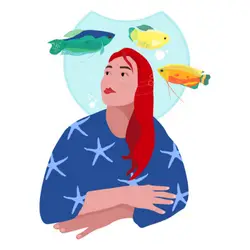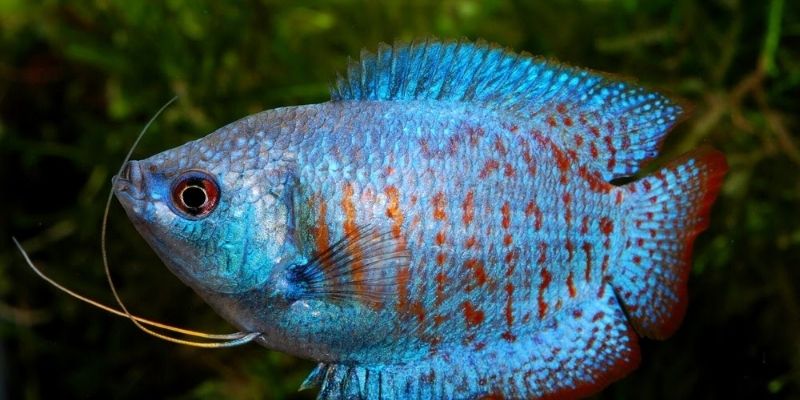Dwarf gourami iridovirus (DGIV) is a newly discovered virus that affects dwarf gouramis. This virus is thought to be highly contagious and can cause mass deaths in affected fish populations.
While there is no known cure for DGIV, researchers are working on developing treatments. In the meantime, it is important to take steps to prevent the spread of this virus and protect your fish from infection.
What is Dwarf gourami iridovirus (DGIV)?
Dwarf gourami iridovirus (DGIV) is a pathogen that affects dwarf gouramis. This virus causes lesions to form on the skin, which can lead to infections in vital organs and organ dysfunction. The skin lesions associated with DGIV make it very easy for secondary infections to take root in affected fish.
Dwarf gourami iridovirus can also affect other types of fish, including bettas and angelfish. Though the virus may not cause serious or widespread infection in these species, they are carriers that are capable of infecting dwarf gouramis.
Understanding the Symptoms of Dwarf Gourami Iridovirus
Symptoms of DGIV can include lethargy, clamped fins, loss of appetite, weight loss, pale color, bulging eyes and bloating. Some fish may also develop cloudy eyes or sunken bellies.
If your dwarf gourami is showing any of these symptoms, it is important to check your tank for other signs of infection. Affected fish should be quarantined and monitored closely by a veterinarian to prevent the spread of the virus to other susceptible fish populations.
What Causes Dwarf Gourami Iridovirus (DGIV)?
Research has shown that DGIV can be transmitted through direct contact as well as through contaminated food and water. In the dwarf gourami, the virus can be transmitted by skin contact or by consuming an infected host.
There is some evidence that suggests DGIV may also be able to infect fish eggs, but this has yet to be conclusively proven.
How do Dwarf Gourami Iridovirus (DGIV) Affect Fish?
Dwarf gourami iridovirus (DGIV) affects the skin and internal organs of dwarf gouramis. The virus causes lesions to form on the skin, which can lead to secondary infections.
In fish with DGIV, the virus can cause lesions to form all over the body and can destroy epithelial tissue. In addition, infection with the virus is thought to injure cells in vital organs such as the kidneys and liver.
How Can I Protect My Fish From Dwarf Gourami Iridovirus?
One of the best ways to prevent your fish from infection with DGIV is through quarantine. At Northfin, all new fish are automatically quarantined for 30 days before they are introduced into established tanks. However, some species cannot be quarantined due to their different water needs.
In addition to quarantine, it is important to pay attention to the compatibility of potential tank mates. Because DGIV affects the skin of dwarf gouramis, keepers should avoid stocking tanks with fish that may damage or scratch this tissue.
This virus is also transmitted through food and water, so make sure your tank’s filter and aerator are cleaned regularly. In addition, treat all water with Aquarium Solutions’ Parasite Clear for freshwater or Parasite Clear Ultra for saltwater to prevent parasitic infection.
Why is Dwarf Gourami Iridovirus (DGIV) an Emerging Virus?
In the wild, fish can develop resistance to viruses and parasites through a process called “wild immunization.” Fish that survive infection with a pathogen will develop antibodies that protect them from future infections. As a result, wild fish populations can minimize the impact of viral outbreaks without human intervention.
However, this process does not occur in captive fish populations. In fact, wild and captive fish are now exposed to many of the same pathogens due to commercial collection, the popularity of ornamental fish and global, viral transmission. In captive fish populations, disease outbreaks often wipe out multiple wild fish stock in a short period of time.
How can I Avoid Spreading Dwarf Gourami Iridovirus?
It is important to practice proper tank maintenance to avoid spreading DGIV from tank to tank. Remove and replace water on a frequent basis and always use a quarantine tank when adding new fish to your aquarium.
Regularly clean or change your filter material and keep the surface of your tank free from uneaten food and organic debris that may harbor viruses, bacteria and parasites. Also, do not overcrowd your tank as this can lead to rapid disease outbreaks.
Ensure that your aquarium is properly filtered and well maintained to prevent the spread of DGIV. At Northfin, all fish are quarantined for 30 days before being introduced into established aquaria.
In addition, Northfin uses a variety of treatments to prevent and eliminate viral outbreaks in our fish room. These include a quarantine period, a full spectrum of treatments and strict cleaning procedures for equipment and tanks.
We hope the above information helps you better understand dwarf gourami iridovirus (DGIV) and how to keep your fish healthy and happy.

